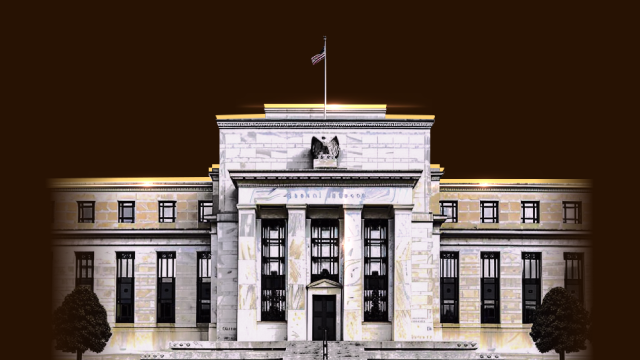IAU250516P78000
- 0.00
- 0.000.00%
Gold Trust Ishares Newsroom
European stocks edged higher, while the dollar and US bond yields both decreased, and Gold dropped nearly 1%. Oil prices remained almost unchanged.
U.S. stock index Futures are nearly flat, European stocks opened slightly higher, the Asia-Pacific stock market shows mixed results, the dollar continues to weaken, while the yen and Swiss Franc strengthen. U.S. Treasury yields continue to fall by over 3 basis points. Spot Gold dropped by about 1%, and oil prices are nearly flat. Most Cryptos rose, with Bitcoin increasing by about 0.4%.
Investors Could Increase Protection Against Weaker Dollar -- Market Talk
Dollar Falls Amid Signs of Easing Price Pressures -- Market Talk
'Sounds Familiar?' Mohamed El-Erian Calls Out Powell's Déjà Vu On Supply Shocks—Economist Draws Historic Parallels On Fed Chair's Latest Message
Bank of America Securities: After the tariff relief, the outlook for the USA interest rate market has been adjusted.
The bank maintains a slightly bullish duration allocation with a medium-term duration (5Y), advocating for a gradual increase in duration at a more stable interest rate position, expecting the 10Y U.S. Treasury yield to stabilize in the Range of 4.5-4.75%.
Fall In April PPI Could Delay US Fed's Rate Cut Move: MIDF
Gold and Bitcoin are exhibiting a "this declines, that rises" trend, with JPMorgan stating that Bitcoin may be more dominant in the second half of the year.
JPMorgan stated that the inverse relationship between Gold and Bitcoin is expected to continue until the end of the year, but several positive catalysts unique to Cryptos may allow Bitcoin to perform better than Gold in the second half of the year.
Dollar Tracks Treasury Yields Lower on Benign US Data
CICC: Delay in the forecast for the Federal Reserve's interest rate cuts to the fourth quarter.
After the Geneva talks between China and the USA, both sides significantly reduced tariffs, lowering the risk of an economic recession in the USA. However, the effective tax rate of 15.5% is still a significant increase from last year's 2.4%, indicating that the inflation risk has not been completely alleviated.
Federal Reserve's Baer: Tariffs cause disruptions in the supply chain or increase inflation, intensifying the survival risks for small and medium-sized enterprises.
The Federal Reserve's Ball emphasized that if tariff measures lead to supply chain disruptions, it could simultaneously bring about the dual risks of economic growth slowing down and inflationary pressures intensifying.
Weak economic data drives the rise in U.S. bonds as the market bets on two interest rate cuts by the Federal Reserve within the year.
As economic data shows a weakening in economic activity and a cooling in inflation, it supports the expectation that the Federal Reserve will implement two rate cuts this year, leading to an increase in US Treasury bond prices.
S&P 500 Rises as Fed-Cut Bets Sink Treasury Yields
Thirty years of "radicalism" may come to an end, and the Federal Reserve may usher in a turning point in this era.
The role of the Federal Reserve is facing redefinition.
Industrials Advance After Muted Inflation Reading - Industrials Roundup
Specter of Early-2020s Inflation Informs Fed's Framework Review -- Market Talk
Federal Reserve Watch for May 15: Powell Says Chances of Inflation Swings Is Greater Now Than in the Past
Daily Roundup of Key US Economic Data for May 15
The "New Federal Reserve News Agency" reports that the Federal Reserve will adjust its framework for interest rate setting, acknowledging that the era of long-term low interest rates may have come to an end.
Nick Timiraos stated that in a world where it is no longer certain whether there will be ultra-low interest rates, Powell is guiding a new Global Strategy. The Federal Reserve is about to adjust its framework for setting interest rates, which is unlikely to affect current policy decisions, but acknowledges that the era of 'long-term low rates' may have ended. This review by the Federal Reserve reflects on the shortcomings of the framework established in 2020—especially its failure to adapt to a wide range of economic scenarios, even when those scenarios seemed unlikely to occur at the time. This review is expected to retain the core concepts of the Federal Reserve's framework, including the 2% inflation target, and ensuring that the public believes the Federal Reserve will maintain low and stable inflation as a key mission.
USD forecast: PPI data fell short of expectations, and Powell's warning dampened market sentiment, leading to a drop in the USD.
On Thursday (May 15), during the European market period, as market optimism regarding the 90-day tariff suspension between the USA and China began to fade, the dollar fell broadly. The USD (DXY) reversed most of its gains from the beginning of the week, with investors turning to safe-haven currencies like the yen and the Swiss franc. Although the tariff ceasefire initially eased market concerns about economic recession, MacroHive strategist Benjamin Ford pointed out that the market has "exhausted" the positive impact of the statement. A Bloomberg report clarified that the USA did not seek a dollar depreciation in trade negotiations, but ongoing concerns about fluctuations in trade policy and the Global perception of US assets.
CEO of JPMorgan: The possibility of a recession in the USA still exists, and the trade war will have lingering effects.
① Dimon pointed out that the possibility of a recession in the USA still exists, and tariff shocks continue to disrupt the Global economy; ② Dimon believes that tariff turmoil could lead to a loss of some investments to the USA, "there will definitely be some consequences. We have annoyed many people."


